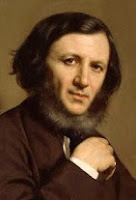Donatello – Renaissance sculptor
Work by prolific artist still on display for all to see
Early Renaissance sculptor Donatello died on this day in Florence in 1466. Generally acknowledged as the greatest sculptor of the 15th century, Donatello left a legacy of wonderful statues in marble and bronze, some still out in the open and delighting visitors to Italy free of charge today. He was born Donato di Niccolò di Betto Bardi in Florence in about 1386. He studied classical sculpture, which later influenced his style, and then worked in a goldsmith’s workshop and in the studio of artist Lorenzo Ghiberti. One of his most famous early works is a statue of David, originally intended for the Cathedral, but which stood instead for many years in Palazzo Vecchio in Florence. Donatello’s work also shows influences of the architect Filippo Brunelleschi, a friend with whom he often travelled to Rome. Brunelleschi’s style can be seen in Donatello’s statues of St Mark and St George, executed for the exterior of the Church of Orsanmichele in Florence, which represent the first translation into sculpture of the architect’s laws on perspective. Donatello was invited to Padua in 1443, where he was to produce one of his greatest works, the bronze equestrian statue of Gattamelata. Read more…
_________________________________________________________________
Carlo Gozzi – playwright
Noble Venetian who fought to preserve commedia dell’arte
Count Carlo Gozzi, the poet and playwright, was born on this day in 1720 in Venice. He was a staunch defender of the traditional Italian commedia dell’arte form of drama and his plays were admired throughout Europe. Commedia dell’arte was a theatrical form that used improvised dialogue and a cast of masked, colourful stock characters such as Arlecchino, Colombina and Pulcinella. Gozzi was against the dramatic innovations made by writers such as Pietro Chiari and Carlo Goldoni. He attacked Goldoni in a satirical poem and then wrote a play, L’amore delle tre melarance - The Love of Three Oranges - in which he portrayed Goldoni as a magician and Chiari as a wicked fairy. The play was first performed by commedia dell’arte actors, who had been out of work due to the dwindling interest in the genre following the innovations of Goldoni and Chiari. It was a great success and revived the fortunes of the company of actors. Having been born into a noble but poor family, Gozzi initially had to go into the army to make a living because his parents could not support him. Read more…
_________________________________________________________________
Pope Sixtus V
Pontiff who cleaned up and rebuilt Rome and reformed church
Pope Sixtus V, whose five-year reign was one of the most effective of any pontiff in history, was born Felice Peretti on this day in 1521 in Grottammare, a coastal resort in the Marche region that was then part of the Papal States. Succeeding Pope Gregory XIII in 1585, Sixtus V inherited an administration that was riddled with corruption and a city of Rome that to a large extent fallen into the hands of thieves and criminal gangs. He responded with a series of measures that brought about profound change with far-reaching consequences for the city and the wider country, making his mark on a scale that few pontiffs had matched before or since. As well as tackling crime with brutal ruthlessness, he introduced significant reforms in the administration of the Catholic Church and commissioned lavish building projects that changed Rome from a medieval city to one of Baroque grandeur. The son of a poor farm hand in Grottammare, the future pope entered a monastery when he was nine years old and joined the Order of Friars Minor three years later. His familiarity with adversity made him resourceful and strong. Read more…
_________________________________________________________________
La Festa di Santa Lucia
Much loved saint was immortalised in song
La festa di Santa Lucia - St Lucy’s Day - will be celebrated all over Italy today. According to tradition, Santa Lucia comes down from the sky with a cart and a donkey and distributes gifts to all the children who have been good, while all the naughty children receive only a piece of coal. Santa Lucia is the patron saint of the city of Syracuse in Sicily. Today, a silver statue of the saint containing her relics will be paraded through the streets before being returned to the Cathedral. In Sicilian folklore there is a legend that a famine ended on Santa Lucia’s feast day when ships loaded with grain entered the harbour. Santa Lucia is also popular with children in parts of northern Italy. In Bergamo, Brescia, Cremona, Lodi and Mantua in Lombardy, and also parts of the Veneto, Trentino, Friuli and Emilia-Romagna, the children will have been expecting the saint to arrive with presents during the night. According to tradition she arrives with her donkey and her escort, Castaldo. Children leave coffee for Santa Lucia, a carrot for the donkey and a glass of wine for Castaldo and they believe they must not watch the saint delivering her gifts. Read more…
Home






























